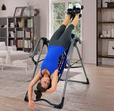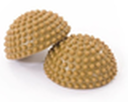
The primary goal of Therapeutic Massage / Bodywork, or "fix-up work”, is to resolve the primary issue you are having with your body. This most typically involves resolving issues of chronic pain and stiffness in specific areas of your body. Some of the techniques used are Deep Tissue Massage, Myofascial release, and energetic techniques such as Craniosacral Therapy and Therapeutic Touch. Even though the goal of Therapeutic Bodywork is not relaxation, you are likely to be quite relaxed by the end of such a session.
Some of the benefits of Therapeutic Massage / Bodywork sessions include pain relief from repetitive motion, motor vehicle accidents, falls, sport injuries, and surgeries. It also helps relieve the tension and stress that typically gets lodged in the classic chronic pain zones of your body such as the head, neck, shoulders, low back, hips and the joints of your body.
With the Therapeutic Massage / Bodywork sessions, you will be resolving your primary concerns, without receiving and experiencing the wholistic benefits of the Rolfing ten session series protocol or recipe. In many cases this involves simply resolving an issue in your physical body. However, within a Therapeutic Bodywork session working with issues of your body-mind (Body Psychology) can and is often used depending on your interests and needs.
Testimonials
After having received two sessions of Therapeutic Massage / Bodywork on the clients forearm weeks after having undergone surgery:
"Thank you so much. You have helped me many times, but never in such a significant, impressive way."
- Alicen
After one Therapeutic Massage / Bodywork session:
"I want to thank you. Whatever you did, for a single treatment, moved me farther and faster along than anything else has."
- Adam
After one Therapeutic Massage / Bodywork session:
Thank you, thank you. I can’t believe the difference in my ankle. My foot is striking the floor differently when I walk. Things are cracking and readjusting and I have some interesting sensations around my left sitting bone. I’m hoping I can hold on to this benefit (which seems like a miracle to me). The wrist is also very much improved. I’m hoping we can repeat the same stuff next week.Thanks again. I’m very, very happy.
- Anonymous
After Receiving two Therapeutic Massage / Bodywork sessions (note: she had received the Rolfing 10 sessions series 2 years prior)
Sorry it took so long for me to update you about the condition of my foot, but my foot feels soooo much better, I even forgot it hurt. It has been giving me no trouble at all. It took a bit for it to feel like this after the last session, but it is great now. I am definitely not walking like a cripple in the morning anymore. Thank-you for the the relief, from the dread, of having to walk on my feet in the morning. Have a Happy New Year!! Thank-you for helping mine be better.
- Pam Donahue
"Thank you so much. You have helped me many times, but never in such a significant, impressive way."
- Alicen
After one Therapeutic Massage / Bodywork session:
"I want to thank you. Whatever you did, for a single treatment, moved me farther and faster along than anything else has."
- Adam
After one Therapeutic Massage / Bodywork session:
Thank you, thank you. I can’t believe the difference in my ankle. My foot is striking the floor differently when I walk. Things are cracking and readjusting and I have some interesting sensations around my left sitting bone. I’m hoping I can hold on to this benefit (which seems like a miracle to me). The wrist is also very much improved. I’m hoping we can repeat the same stuff next week.Thanks again. I’m very, very happy.
- Anonymous
After Receiving two Therapeutic Massage / Bodywork sessions (note: she had received the Rolfing 10 sessions series 2 years prior)
Sorry it took so long for me to update you about the condition of my foot, but my foot feels soooo much better, I even forgot it hurt. It has been giving me no trouble at all. It took a bit for it to feel like this after the last session, but it is great now. I am definitely not walking like a cripple in the morning anymore. Thank-you for the the relief, from the dread, of having to walk on my feet in the morning. Have a Happy New Year!! Thank-you for helping mine be better.
- Pam Donahue
The problems of poor posture, muscle tension, and stress-caused pain are corrected by seeing them through the lens of kinesthetic awareness. Normal kinesthetic awareness is lacking in much of the population and typically overlooked by health care practitioners.
Craig Williamson
Craig Williamson
Book List
Bob Cooley - The Genius of Flexibility - www.thegeniusofflexibility.com
Craig Williamson - Muscular Retraining for Pain-Free Living Paperback
Miranda Esmonde-White - Aging Backwards – Reverse the aging process and look 10 years younger in 30 minutes a day
Pete Egoscue - Pain Free a Revolutionary Method For Stopping Chronic Pain - http://www.egoscue.com
Rob Garza - An article to promote learning about anatomy and how the human body works. https://www.acls.net/study-guide-body-systems.htm
Craig Williamson - Muscular Retraining for Pain-Free Living Paperback
Miranda Esmonde-White - Aging Backwards – Reverse the aging process and look 10 years younger in 30 minutes a day
Pete Egoscue - Pain Free a Revolutionary Method For Stopping Chronic Pain - http://www.egoscue.com
Rob Garza - An article to promote learning about anatomy and how the human body works. https://www.acls.net/study-guide-body-systems.htm
Pain Resolution
How to Heal - Education
Another important ingredient in Rolfing, Therapeutic Massage / Bodywork and general healing your body is by understanding why your body is hurting, how it got that way and what exactly is needed to heal the issue.
The Role of the Nervous system - Why do we experience pain?

When pain does not go away, we call it chronic. The question is what is the origins of chronic pain: the type that is always moving around or does not go away? The role of the nervous system is critical in answering this question. It boils down to the nervous system giving our body a pain response. It does so because the nervous system's job is to keep us alive and to survive. So, it will alert us of of any emanate danger and reminds us of any past dangers. The problem is that he nervous system may continue to give us a pain response even if the danger from the past is now gone. It may give a pain response that is disproportionate or to what is actually going on. This is key. Once you learn what the nervous system is trying to protect you from and the danger no longer present, the pain response has the potential to greatly lessen and stop.
Lormimer Moslie -Why Things Hurt
Why is your body giving you a pain response? https://www.youtube.com/watch?v=gwd-wLdIHjs
Why you are getting the pain response extended version - https://youtu.be/lCF1_Fs00nM
Pain Revolution Organization - https://www.painrevolution.org
Understanding Pain web site - https://www.msk.org.au
Neil Pearson - Brain Plastisity - http://www.lifeisnow.ca - http://www.youtube.com/watch?v=66LP2XdyDxA
Silje Endersen Rme - Back Pain study: Major contributor life circumstances / - https://youtu.be/tiwmVTScusg
John E. Sarno, M.D. - 30 years of clinical experience of how we hold our stress in our back – (The Mind-Body Connection)
- https://www.youtube.com/watch?v=2B2IE0o7diU
- https://www.youtube.com/watch?v=UjG-8GE2Wf4
-https://www.youtube.com/watch?v=GRXCRxNMN_Q
- https://www.youtube.com/watch?v=iYIOOURMuS0
Brain Plasticity - Resolution of pain is possible
When the nervous system gives us a pain response over and over (chronic) it sets up a neural pathway between the brain and the area(s) of the body that chronically hurt and the this becomes habitual like a groove in a record. Fortunately, we have found that this chronic response can be changed. This ability for the nervous system to change is called brain plasticity.
You Tube Example - Brain Plasticity
Neil Pearson - http://www.lifeisnow.ca
http://www.youtube.com/watch?v=66LP2XdyDxA
http://www.lifeisnow.ca
Lormimer Moslie -Why Things Hurt
Why is your body giving you a pain response? https://www.youtube.com/watch?v=gwd-wLdIHjs
Why you are getting the pain response extended version - https://youtu.be/lCF1_Fs00nM
Pain Revolution Organization - https://www.painrevolution.org
Understanding Pain web site - https://www.msk.org.au
Neil Pearson - Brain Plastisity - http://www.lifeisnow.ca - http://www.youtube.com/watch?v=66LP2XdyDxA
Silje Endersen Rme - Back Pain study: Major contributor life circumstances / - https://youtu.be/tiwmVTScusg
John E. Sarno, M.D. - 30 years of clinical experience of how we hold our stress in our back – (The Mind-Body Connection)
- https://www.youtube.com/watch?v=2B2IE0o7diU
- https://www.youtube.com/watch?v=UjG-8GE2Wf4
-https://www.youtube.com/watch?v=GRXCRxNMN_Q
- https://www.youtube.com/watch?v=iYIOOURMuS0
Brain Plasticity - Resolution of pain is possible
When the nervous system gives us a pain response over and over (chronic) it sets up a neural pathway between the brain and the area(s) of the body that chronically hurt and the this becomes habitual like a groove in a record. Fortunately, we have found that this chronic response can be changed. This ability for the nervous system to change is called brain plasticity.
You Tube Example - Brain Plasticity
Neil Pearson - http://www.lifeisnow.ca
http://www.youtube.com/watch?v=66LP2XdyDxA
http://www.lifeisnow.ca
The order of things – Release / Mobilize / Strengthen
For your body to recover and be restored, three things must take place. Your body must Release, Mobilize, and Strengthen. You can do much of this on your own and with the help of practitioners.
1. Releasing means un-sticking the tissues (muscles, connective tissue, scar tissue, tendons, and ligaments) that are adhered or stuck to one another like glue or joints that are not free to move appropriately. Your body can be manually released by someone else with massage or therapeutic bodywork, and you can learn to release your own body with foam and ball rolling and with yoga and stretching techniques.
2. Mobilizing means getting these regions of your body that have been stuck, to move. This can be gross and or isolated micro-movements. For example you can tighten all of your fingers into a fist and then you can isolate one finger and only move it in its full range of motion. It entails learning how to tighten or engage, release, and coordinate movements in their full range of motion. It involves learning new movement patterns. For example, can you tighten and release one glute or bum cheek at a time, first one then the other? If not, the one you cannot move so well is likely stiff, not mobile, and you are not able to coordinate its movement. This makes this glue muscle or region of your body weak.
3. Strengthening means that your body will regain vitality and hardiness now that you are able move it more freely. You gain strength because it is being used. And once it is being used, you gain more muscle strength. Strength comes when you are able to consciously coordinate movement specifically to the regions of the body that have been stiff, ridged, weak, and immobile. Strength naturally returns once your ability to move is regained. Now that is pretty cool!
This process of restoring function is most effect when this happens in this order or all at the same time in unison. For example, if you can receive Rolfing and have at the same time have a Tai Chi, Chi Gong, Yoga, Pilates, Essentrics, or stretching practice. If one of these three is not addressed, recovery will likely not happen.
1. Releasing means un-sticking the tissues (muscles, connective tissue, scar tissue, tendons, and ligaments) that are adhered or stuck to one another like glue or joints that are not free to move appropriately. Your body can be manually released by someone else with massage or therapeutic bodywork, and you can learn to release your own body with foam and ball rolling and with yoga and stretching techniques.
2. Mobilizing means getting these regions of your body that have been stuck, to move. This can be gross and or isolated micro-movements. For example you can tighten all of your fingers into a fist and then you can isolate one finger and only move it in its full range of motion. It entails learning how to tighten or engage, release, and coordinate movements in their full range of motion. It involves learning new movement patterns. For example, can you tighten and release one glute or bum cheek at a time, first one then the other? If not, the one you cannot move so well is likely stiff, not mobile, and you are not able to coordinate its movement. This makes this glue muscle or region of your body weak.
3. Strengthening means that your body will regain vitality and hardiness now that you are able move it more freely. You gain strength because it is being used. And once it is being used, you gain more muscle strength. Strength comes when you are able to consciously coordinate movement specifically to the regions of the body that have been stiff, ridged, weak, and immobile. Strength naturally returns once your ability to move is regained. Now that is pretty cool!
This process of restoring function is most effect when this happens in this order or all at the same time in unison. For example, if you can receive Rolfing and have at the same time have a Tai Chi, Chi Gong, Yoga, Pilates, Essentrics, or stretching practice. If one of these three is not addressed, recovery will likely not happen.
I. Release
1. Releasing Releasing means un-sticking the tissues (muscles, connective tissue, scar tissue, tendons, and ligaments) that are adhered or stuck to one another like glue or joints that are not free to move appropriately.
Your body can be manually released by someone else with Massage, Rolfing or Therapeutic Bodywork, and you can learn to release your own body with foam and ball rolling and with yoga and stretching techniques.
Your body can be manually released by someone else with Massage, Rolfing or Therapeutic Bodywork, and you can learn to release your own body with foam and ball rolling and with yoga and stretching techniques.
Passive Shaking
Chi Machine - http://www.chimachine4u.com/chimachine.html
Standing Vibration Shacking Plate
Passive Stretching
Pete Egoscue
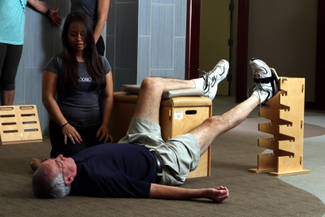
A Revolutionary Method to Stop Chronic Pain:
Egoscue is a proven method that gets to the root of your chronic pain by returning your body to proper alignment, function and balance.
Web site - http://www.egoscue.com
Pete Egoscue - Pain Free -a Revolutionary Method For Stopping Chronic Pain
Egoscue is a proven method that gets to the root of your chronic pain by returning your body to proper alignment, function and balance.
Web site - http://www.egoscue.com
Pete Egoscue - Pain Free -a Revolutionary Method For Stopping Chronic Pain

Restorative Yoga
Yin Yoga
Yin Yoga
Traction and Inversion
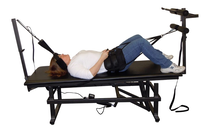
Neck and low back
https://pettibonsystem.com/product/pt-5-decompression-table-package-accessories-vibration-inversion/
https://pettibonsystem.com/product/pt-5-decompression-table-package-accessories-vibration-inversion/
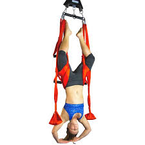
From the Hips - At the Gym
Some more hard core examples
Hips - https://www.youtube.com/watch?v=PECGODC2iOo&t=161s
Hips - https://www.youtube.com/watch?v=1Mkhj0P3Nsw&t=127s
Low back and QL / Abductors / traction and then Activation
https://www.youtube.com/watch?v=eixkcrX_Qh8
Some more hard core examples
Hips - https://www.youtube.com/watch?v=PECGODC2iOo&t=161s
Hips - https://www.youtube.com/watch?v=1Mkhj0P3Nsw&t=127s
Low back and QL / Abductors / traction and then Activation
https://www.youtube.com/watch?v=eixkcrX_Qh8
Foam & Ball Rolling

A part of therapeutic bodywork is learning ways that you can help yourself such as with foam and ball rolling. It is a way to give yourself a deep tissue corrective bodywork.
The Melt Method - (Effective Foam Rolling instruction) - https://www.meltmethod.com
Dynamic Vibrating Foam Roller Hyper Ice - https://youtu.be/WdCgGE4r3HM
Examples of Foam Rolling
https://youtu.be/WdCgGE4r3HM
http://www.youtube.com/watch?v=QJLxruO3su0
http://www.youtube.com/watch?v=8caF1Keg2XU
https://www.youtube.com/watch?v=UQiwoJ-IESQ
www.youtube.com/watch?v=UQiwoJ-IESQ
Examples of Ball Rolling
www.youtube.com/watch?v=uE2GkEEbiwI&feature=related
www.youtube.com/watch?v=a7S7z3gOMDk&feature=related
Many types - http://www.treadmillfactory.ca/c-84-foam-rollers.html?gclid=CK2ym4nFia0CFc3DKgod71_NoA
Fitter First www.fitter1.com - http://www.fitter1.com/Catalog/Items/FROL.aspx
Rumble Roller (Foam Roller with “spikes”) - http://www.rumbleroller.com
Ball Rolling Soft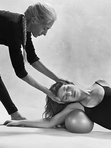
Yamuna Balls - http://www.yamunabodyrolling.com
|
Ball Rolling - Hard
Lacrosse
Tennis balls Golf balls |
Myofascial Visceral Release
Wurn

Joint Release Techniques
Gary Crowley

Do it yourself Joint Release Techniques Tutorials
https://www.diyjointpainrelief.com
https://www.diyjointpainrelief.com
Low Back Mechanics and Rehab
Dr. Stuart McGill

Understand the Mechanics of low back pain &
How to mobilize and strengthen the low back pain spine
https://www.youtube.com/watch?v=IyGaKuSzD_M
Book - Back Mechanic - the secretes to a health spine your doctor isn’t telling you -
The step by step McGill Method to fix back pain
Book - Ultimate Back Fitness and Performance
How to mobilize and strengthen the low back pain spine
https://www.youtube.com/watch?v=IyGaKuSzD_M
Book - Back Mechanic - the secretes to a health spine your doctor isn’t telling you -
The step by step McGill Method to fix back pain
Book - Ultimate Back Fitness and Performance
II Mobilize
2. Mobilizing means getting these regions of your body that have been stuck, to move. This can be gross and or isolated micro-movements. For example you can tighten all of your fingers into a fist and then you can isolate one finger and only move it in its full range of motion. It entails learning how to tighten or engage, release, and coordinate movements in their full range of motion. It involves learning new movement patterns. For example, can you tighten and release one glute or bum cheek at a time, first one then the other? If not, the one you cannot move so well is likely stiff, not mobile, and you are not able to coordinate its movement. This makes this glue muscle or region of your body weak.
Breath
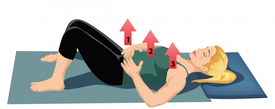
Learning to breath fully and properly is fundamental to movement and to pain resolution.
Nose Breath - James Nestor - https://www.youtube.com/watch?v=zWQxNoqKE6E
Begin with breathing through the nose and out the mouth.
The Benefits of Breath
To reduce Stress and Tension - Max Strom - https://www.youtube.com/watch?v=4Lb5L-VEm34
3-Part Breathing
https://www.youtube.com/watch?v=PFByTJVVX38
To improve exercise performance
Explained with riding bike - http://www.bicycling.com/training/skills/how-changing-your-breathing-can-improve-your-performance?cid=soc_BicyclingMag_TWITTER_Bicycling__
Nose Breathing for walking and exercising - https://lifespa.com/ayurvedic-treatment-health-topics/nose-breathing
Nose Breath - James Nestor - https://www.youtube.com/watch?v=zWQxNoqKE6E
Begin with breathing through the nose and out the mouth.
The Benefits of Breath
To reduce Stress and Tension - Max Strom - https://www.youtube.com/watch?v=4Lb5L-VEm34
3-Part Breathing
https://www.youtube.com/watch?v=PFByTJVVX38
To improve exercise performance
Explained with riding bike - http://www.bicycling.com/training/skills/how-changing-your-breathing-can-improve-your-performance?cid=soc_BicyclingMag_TWITTER_Bicycling__
Nose Breathing for walking and exercising - https://lifespa.com/ayurvedic-treatment-health-topics/nose-breathing
Transformational Breath Work

Coordinated Movements - Micro Movements
Areas of your body that are in pain, are injured, or compromised usually don't know how to move independently from the rest of the body. They typically lack coordination. They may know how to contract, but they do not know how to let go. They usually are attempting to hold the body together. They know how to concentrically contact but do not know how to eccentrically engage and elongate. The point here is to learn how to move the areas that are lacking conscious movement.
Feldenkrais Method
M Feldenkrais
M Feldenkrais
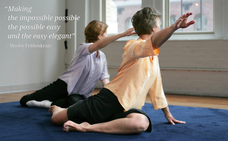
Feldenkrais Method - www.feldenkrais.com
Practitioner:
Timothy Rose – 780-708-0027- [email protected]
Anat Baniel Method (Feldencriss origin) - http://www.anatbanielmethod.com
Practitioner:
Timothy Rose – 780-708-0027- [email protected]
Anat Baniel Method (Feldencriss origin) - http://www.anatbanielmethod.com
Somatics Thomas Hanna (founder) - www.somaticsed.com/education.html - http://hannasomatics.com
To Release Neck tension
http://www.youtube.com/watch?v=IlsaFGBbk1c&list=PLd-SXe1vtYR7rlqDlPogeNg5CxClum9bo
To Release Low Back (starts at min 2:52)
http://www.youtube.com/watch?v=IlsaFGBbk1c&list=PLd-SXe1vtYR7rlqDlPogeNg5CxClum9bo
Practitioner:
Somatic Essentials - Pandiculation - http://essentialsomatics.com)
Karen Olsen - 780-967-3266, cell 780-266-9639
Anat Baniel Method (Feldencriss origin) - http://www.anatbanielmethod.com
To Release Neck tension
http://www.youtube.com/watch?v=IlsaFGBbk1c&list=PLd-SXe1vtYR7rlqDlPogeNg5CxClum9bo
To Release Low Back (starts at min 2:52)
http://www.youtube.com/watch?v=IlsaFGBbk1c&list=PLd-SXe1vtYR7rlqDlPogeNg5CxClum9bo
Practitioner:
Somatic Essentials - Pandiculation - http://essentialsomatics.com)
Karen Olsen - 780-967-3266, cell 780-266-9639
Anat Baniel Method (Feldencriss origin) - http://www.anatbanielmethod.com
Franklin Method - https://franklinmethod.co
Core Engagement - Hypopressive

Hypopressive is a true engagement of your core for proper function of your entire body. It trains your body to restore your pelvic health and to true engagement and function of your core. Traditional approaches to pelvic health and core exercise focus training one segment of the core at a time unlike the Hypopressive – Low Pressure Fitness programs approach to functional ‘core’ health.
To Learn more - click here
Hypopressives – https://coresetfitness.com
Videos - https://coresetfitness.com/videos
Where to Learn:
Practitioner Tracy at Cura - (780) 443-4473
Classes - Cura (780-433-4473
Workshop - Trista Zinn – www.russellhillchiropractic.com
To Learn more - click here
Hypopressives – https://coresetfitness.com
Videos - https://coresetfitness.com/videos
Where to Learn:
Practitioner Tracy at Cura - (780) 443-4473
Classes - Cura (780-433-4473
Workshop - Trista Zinn – www.russellhillchiropractic.com
Movement Education - Posture and Alignment
Rolfing Movement Integration
Ida P. Rolf
Ida P. Rolf

Experience the joy of movement! Move like never before. See how to have better posture, greater athletic performance and to rehabilitate. Learn how to walk, run, stand, work, and/or do your sport more effectively/efficiently. Get acquainted with your breath, and how trauma is held in the body. Rolfing Movement is a system of movement & embodiment education. The purpose is to increase ease, joy, and efficiency of movement, to develop a more powerful sense of self, and to release the stress caused by "gravity resisting" movement patterns. It is a process of exploration, education, and self-discovery. The work is gentle and non-intrusive. The Rolf Institutes description of Rolfing Movement - www.rolf.org/about/movement
Primal Posture - The Gokhale Method
Esther Gokhale

Explained on you tube- https://www.youtube.com/watch?v=mtQ1VqGGU74
- Book - 8 Steps to a Pain - Free Back: (Natural Posture Solutions for Pain in the Back, Neck, Shoulder, Hip, Knee, and Foot)
- Practitioner
Mati Messager - (587) 937-1730 - Gokhale Method Teacher Bio
- How to ride a bike with a straight spine - https://gokhalemethod.com/blog/64161?utm_source=170810NL&utm_campaign=PositiveStance&utm_medium=email
- Book - 8 Steps to a Pain - Free Back: (Natural Posture Solutions for Pain in the Back, Neck, Shoulder, Hip, Knee, and Foot)
- Practitioner
Mati Messager - (587) 937-1730 - Gokhale Method Teacher Bio
- How to ride a bike with a straight spine - https://gokhalemethod.com/blog/64161?utm_source=170810NL&utm_campaign=PositiveStance&utm_medium=email
The J Spine - The Gokhale Method
Article - Lost Posture: Why Some Indigenous Cultures May Not Have Back Pain - http://www.npr.org/sections/goatsandsoda/2015/06/08/412314701/lost-posture-why-indigenous-cultures-dont-have-back-pain
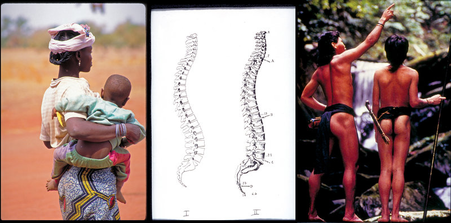
Primal posture: Ubong tribesmen in Borneo (right) display the perfect J-shaped spines. A woman in Burkina Faso (left) holds her baby so that his spine stays straight. The center image shows the S-shaped spine drawn in a modern anatomy book (Fig. I) and the J-shaped spine (Fig. II) drawn in the 1897 anatomy book Traite d'Anatomie Humaine.
Courtesy of Esther Gokhale and Ian Mackenzie/Nomads of the Dawn
Courtesy of Esther Gokhale and Ian Mackenzie/Nomads of the Dawn
III Strengthening - Active Mobility
3. Strengthening means that your body will regain vitality and hardiness now that you are able move it more freely. You gain strength because it is being used. And once it is being used, you gain more muscle strength. Strength comes when you are able to consciously coordinate movement specifically to the regions of the body that have been stiff, ridged, weak, and immobile. Strength naturally returns once your ability to move is regained. Now that is pretty cool!
Pilates: One-on-one with equipment

Gyrotonics: - One on one with equipment - Round Circular Movents
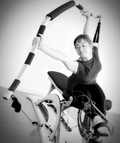
Yoga: Restorative and Critical Alignment
Meridian Stretches - The Genius of Flexibility
Bob Cooley

Corrective Meridian Stretches is a form of stretching that is rehabilitative, corrective, and dynamic. It involves resistance flexibility or isometric stretching. It also targets and treats the organs via the meridians of the body. It is good for anyone of all abilities.
Bob Cooley - The Genius of Flexabiltiy - www.thegeniusofflexibility.com
A student of Bob Cooley and a teacher of his work - Luther Cowden - http://www.flexiblestrength.com
A series of the dynamic and meridian stretches on you tube with Luther Cowden - https://www.youtube.com/playlist?list=PLE728D42C14E01F2D
Bob Cooley - The Genius of Flexabiltiy - www.thegeniusofflexibility.com
A student of Bob Cooley and a teacher of his work - Luther Cowden - http://www.flexiblestrength.com
A series of the dynamic and meridian stretches on you tube with Luther Cowden - https://www.youtube.com/playlist?list=PLE728D42C14E01F2D
Foundation Training - The Founder
Low Back Rehab / Stretch / Strengthen / Traction
Dr. Eric Goodman

Foundation Training - web site - https://www.foundationtraining.com
The Basic Founder Exercise - Explained & Shown
With Dr. Mercola - http://youtu.be/HKH_JVlTGDQ
The Basic Founder Exercise - Follow Along
Pre-Founder - 1. Modified Basic - or you are currently in back pain - 4 min-http://youtu.be/aGZlP3jieRI
Basic - 2. Basic - plus two others - 5 min - http://www.youtube.com/watch?v=vOgxWp0WyiI
3. Basic - Advanced - 12 min - https://www.youtube.com/watch?v=4BOTvaRaDjI
Prone (face down) - 5 min - http://youtu.be/vmhu-yZGY_A
Supine (face up) - 5 min - https://www.youtube.com/watch?v=qcJHbV0v11w
Learn more - Ted Talk - https://www.youtube.com/watch?v=MBlM5in2IQA
Learn more - Interview with Dr. Mercola - https://www.youtube.com/watch?v=Bsbz8qxPGNs
Book - Foundation: Redefine Your Core, Conquer Back Pain, and Move with Confidence
Practitioner in Edmonton
Ananda Masri -780-399-3424 - http://integratedbody.ca
Knees over Toes - Strengthen Knees & Hip Flexors
Ben Patrick

What is Knees over Toes - https://www.atgonlinecoaching.com
The Basics with Ben Patrick - https://www.youtube.com/watch?v=6pEpIc9MYuk
The Basics with Tim Rementer - https://www.youtube.com/watch?v=_m6mtkejKNU
The Basics with Ben Patrick - https://www.youtube.com/watch?v=6pEpIc9MYuk
The Basics with Tim Rementer - https://www.youtube.com/watch?v=_m6mtkejKNU
Eldoa - Lengthen and Strength
Dr. Guy VOYER

What is Eldoa - https://legacyperformwell.com/guy-voyer-history-eldoa
- https://www.eldoamethod.com
Low back decompression - https://www.youtube.com/watch?v=_0R1Mucw4ks
Spine - https://www.youtube.com/watch?v=LqYrE2HhRIA
- https://www.eldoamethod.com
Low back decompression - https://www.youtube.com/watch?v=_0R1Mucw4ks
Spine - https://www.youtube.com/watch?v=LqYrE2HhRIA
Precision Movement
Eric Wong

Hip & Sacrum
Theory - https://www.youtube.com/watch?v=jn8Z8Rxuepc
Rehab exercise - https://www.youtube.com/watch?v=jz4dDv1nqyk
Hip Flexibility Program - https://www.precisionmovement.coach/hip-flexibility-solution
Shoulders - https://www.youtube.com/watch?v=Umx6ywiJv_I&t=617s
Kyphosis – Rounded upper back - Hunch back
1. Standard exercises - https://www.youtube.com/watch?v=yX2ZNzMudEs
2. Essentric exercise - https://www.youtube.com/watch?v=iLOryGxlssI
Ankles
For mobility - https://www.youtube.com/watch?v=CbySCetzSp
Feet
Plantar fascia - Medial line - https://www.youtube.com/watch?v=UWQAYPJBtiM
Theory - https://www.youtube.com/watch?v=jn8Z8Rxuepc
Rehab exercise - https://www.youtube.com/watch?v=jz4dDv1nqyk
Hip Flexibility Program - https://www.precisionmovement.coach/hip-flexibility-solution
Shoulders - https://www.youtube.com/watch?v=Umx6ywiJv_I&t=617s
Kyphosis – Rounded upper back - Hunch back
1. Standard exercises - https://www.youtube.com/watch?v=yX2ZNzMudEs
2. Essentric exercise - https://www.youtube.com/watch?v=iLOryGxlssI
Ankles
For mobility - https://www.youtube.com/watch?v=CbySCetzSp
Feet
Plantar fascia - Medial line - https://www.youtube.com/watch?v=UWQAYPJBtiM
Essentrics - Therapeutic and Dynamic Movement / Stretching
Miranda Esmonde-White
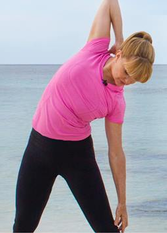
Essentrics -
1. A dynamic workout that simultaneously lengthens and strengthens every muscle in the body, resulting in greater joint mobility and lean, long muscles.
2. A full-body technique that works through the muscle chains, liberating and empowering the muscles, relieving them from tension in the process.
3. A completely original workout that draws on the flowing movements of tai chi which create health and balance, the strengthening theories behind ballet which create long, lean, flexible muscles and the healing principles of physiotherapy which create a pain free body.
4. Medical Definition: Eccentric training is defined as active contraction of a muscle occurring simultaneously with lengthening of the muscle.
Essentrics Web site - http://www.essentrics.com/index.html
Classical Stretch web site - http://www.classicalstretch.com
Miranda Esmonde-White - Aging Backwards – Reverse the aging process and look 10 years younger in 30 minutes a day
Essentrics Classes:
Edmonton - Lori Griffith - 780-916-4483 - www.eonefitness.ca
St Albert - Carol Smith 780-460-2639
1. A dynamic workout that simultaneously lengthens and strengthens every muscle in the body, resulting in greater joint mobility and lean, long muscles.
2. A full-body technique that works through the muscle chains, liberating and empowering the muscles, relieving them from tension in the process.
3. A completely original workout that draws on the flowing movements of tai chi which create health and balance, the strengthening theories behind ballet which create long, lean, flexible muscles and the healing principles of physiotherapy which create a pain free body.
4. Medical Definition: Eccentric training is defined as active contraction of a muscle occurring simultaneously with lengthening of the muscle.
Essentrics Web site - http://www.essentrics.com/index.html
Classical Stretch web site - http://www.classicalstretch.com
Miranda Esmonde-White - Aging Backwards – Reverse the aging process and look 10 years younger in 30 minutes a day
Essentrics Classes:
Edmonton - Lori Griffith - 780-916-4483 - www.eonefitness.ca
St Albert - Carol Smith 780-460-2639
Fascial Fitness

Learn about Fascial Fitness:
View on You Tube - http://www.youtube.com/watch?v=92bQd8XT2I0\
Fascial Fitness explained on a PDF - http://www.theradiantbody.com/files/upload/FascialFitnessTerraRosa.pdf or Click Here
Fascial Fitness web site - http://www.anatomytrains.com/explore/fascialfitness
To purchase Fascial Fitness Exercise DVD’s - http://fasciadvds.com
View on You Tube - http://www.youtube.com/watch?v=92bQd8XT2I0\
Fascial Fitness explained on a PDF - http://www.theradiantbody.com/files/upload/FascialFitnessTerraRosa.pdf or Click Here
Fascial Fitness web site - http://www.anatomytrains.com/explore/fascialfitness
To purchase Fascial Fitness Exercise DVD’s - http://fasciadvds.com
Joint Mobility - Into Flow
Scott Sonnon

Into Flow - http://www.intu-flow.com
Into Flow Philophy and Movement Exercies
http://www.youtube.com/watch?v=bsMPqP7hxRk&feature=relmfu
Joint Mobility Exercises
Beginner - https://www.youtube.com/watch?v=AkUEk52YOzo
Intermediate - https://www.youtube.com/watch?v=MUvZvBeQm0c
pt2 - https://www.youtube.com/watch?v=f1976WyclDA
Advanced - https://www.youtube.com/watch?v=eNbQTgezuNA
pt2 - https://www.youtube.com/watch?v=LqKm4Q3nKpQ
Basic Joint Mobility Exercises Stick Figures - Click Here
Scott Sonnon's history - Ted Talk - https://www.youtube.com/watch?v=bxkBqFbbAP0
Into Flow Philophy and Movement Exercies
http://www.youtube.com/watch?v=bsMPqP7hxRk&feature=relmfu
Joint Mobility Exercises
Beginner - https://www.youtube.com/watch?v=AkUEk52YOzo
Intermediate - https://www.youtube.com/watch?v=MUvZvBeQm0c
pt2 - https://www.youtube.com/watch?v=f1976WyclDA
Advanced - https://www.youtube.com/watch?v=eNbQTgezuNA
pt2 - https://www.youtube.com/watch?v=LqKm4Q3nKpQ
Basic Joint Mobility Exercises Stick Figures - Click Here
Scott Sonnon's history - Ted Talk - https://www.youtube.com/watch?v=bxkBqFbbAP0
Joint Mobility - Controlled Articular Rotation (CARS) - Under Tension
Kelly Gonzalez
Kelly Gonzalez

Take each joint through a full range of motion under tension.
Ian Markow - Daily Mobility Routine (C.A.R.S)
Kelly Gonzalez - A daily joint mobility routine: Controlled Articular Rotations (CARS)
Dr. Andreo Spina - https://barbend.com/andreo-spina-kinstretch
- https://functionalanatomyblog.com
Ian Markow - Daily Mobility Routine (C.A.R.S)
Kelly Gonzalez - A daily joint mobility routine: Controlled Articular Rotations (CARS)
Dr. Andreo Spina - https://barbend.com/andreo-spina-kinstretch
- https://functionalanatomyblog.com
Body Regions - Under Construction
Head
Vertigo Clearing PBBV Epley maneuver at home - https://www.youtube.com/watch?v=BtT2PDJVXlk
Neck
Forward Neck & Hump - https://www.youtube.com/watch?v=6C-wfV27bzI - https://youtu.be/6Uko-gs--C8
Exercise for neck Pain - https://mail.google.com/mail/u/0/?tab=rm&ogbl#inbox/FMfcgxvwxxfKJQTLPFkdShjmZJwfsCxL?projector=1
Exercise for neck Pain - https://mail.google.com/mail/u/0/?tab=rm&ogbl#inbox/FMfcgxvwxxfKJQTLPFkdShjmZJwfsCxL?projector=1
Upper Back (Stiff or Hunched)

How to correct kyphosis, Hunched back, over rounding of the upper back hump
Exercises with a sock and a Foam Roller (Bob and Brad) - https://youtu.be/6Uko-gs--C8
Strengthen and activation exercises - https://youtu.be/gfSCZbb9MOY
Strand up straight reminder brace
Exercises with a sock and a Foam Roller (Bob and Brad) - https://youtu.be/6Uko-gs--C8
Strengthen and activation exercises - https://youtu.be/gfSCZbb9MOY
Strand up straight reminder brace
Shoulders (Tight or Frozen)

Essentrics - Miranda Esmonde-White
Frozen Shoulder Explained - https://vimeo.com/20206684
Very short exercise - https://vimeo.com/20216296
Western intervention - Shoulder Hydrodilatation - Dilation
Pete Egoscue
Shoulders x 3 – 5min - https://www.youtube.com/watch?v=c0_qtY5kX_g
Standing Arm Circles - https://www.youtube.com/watch?v=jZo6ABS1U0M&list=PLVudX9c2BeTtLZE7Zi2hqwU6GHoGNTmmb
Standing elbow curls - https://www.youtube.com/watch?v=p9zAf87T-es&index=2&list=PLVudX9c2BeTtLZE7Zi2hqwU6GHoGNTmmb
Ben Patrick
Strengthen and Stretch Shoulder and Thoracic spine
https://www.youtube.com/watch?v=574AUMqOK4k
Shoulders Blade Isolation Movement - https://www.facebook.com/ofcourseonline/videos/625802524287249/
Sub-Scapula Isolation exercise / stretch - https://www.youtube.com/watch?v=kL3cIDFUafU
Frozen Shoulder Explained - https://vimeo.com/20206684
Very short exercise - https://vimeo.com/20216296
Western intervention - Shoulder Hydrodilatation - Dilation
Pete Egoscue
Shoulders x 3 – 5min - https://www.youtube.com/watch?v=c0_qtY5kX_g
Standing Arm Circles - https://www.youtube.com/watch?v=jZo6ABS1U0M&list=PLVudX9c2BeTtLZE7Zi2hqwU6GHoGNTmmb
Standing elbow curls - https://www.youtube.com/watch?v=p9zAf87T-es&index=2&list=PLVudX9c2BeTtLZE7Zi2hqwU6GHoGNTmmb
Ben Patrick
Strengthen and Stretch Shoulder and Thoracic spine
https://www.youtube.com/watch?v=574AUMqOK4k
Shoulders Blade Isolation Movement - https://www.facebook.com/ofcourseonline/videos/625802524287249/
Sub-Scapula Isolation exercise / stretch - https://www.youtube.com/watch?v=kL3cIDFUafU
Rotator Cuff
Flossing the Suprascapular Nerve - https://youtu.be/hKXxlyYpH4w
Low Back
Stretch Routine must include:
Pete Egoscue
Low Back exercise - 1. https://www.youtube.com/watch?v=rqNnmC09eUU&list=PLrventx7KjJoOCR2HNwiobyf_Ko09lEaA
2. https://www.youtube.com/watch?v=8LNEjJkPHKM
Pete Egoscue
Low Back exercise - 1. https://www.youtube.com/watch?v=rqNnmC09eUU&list=PLrventx7KjJoOCR2HNwiobyf_Ko09lEaA
2. https://www.youtube.com/watch?v=8LNEjJkPHKM
Sciatic Nerve - Nerve Flossing
Hips

Frozen Hip
Explanation - What is a frozen hip - Read about it (click here)
Movement to Exercise and lubricate the joints - https://www.youtube.com/watch?v=XcBnjYv9gU
Bursitis - Hip Exercise: You Tube https://www.youtube.com/watch?v=cPDZb5YPn4U
Bursitis - Hip exercise: Chart format
Explanation - What is a frozen hip - Read about it (click here)
Movement to Exercise and lubricate the joints - https://www.youtube.com/watch?v=XcBnjYv9gU
Bursitis - Hip Exercise: You Tube https://www.youtube.com/watch?v=cPDZb5YPn4U
Bursitis - Hip exercise: Chart format
IT Band

Psoas

Psoas release:
- Lunge with a twist - https://caloriebee.com/workout-routines/Fix-Anterior-Pelvic-Tilt
- Leg hanging while standing on yoga block - https://corewalking.com/releasing-the-psoas-foot-on-a-block/
- Lunge with a twist - https://caloriebee.com/workout-routines/Fix-Anterior-Pelvic-Tilt
- Leg hanging while standing on yoga block - https://corewalking.com/releasing-the-psoas-foot-on-a-block/
Knees

Strengthen your knees with Knees over Toes - https://www.atgonlinecoaching.com
The Basics with Ben Patrick - https://www.youtube.com/watch?v=6pEpIc9MYuk
Bulletproof with Ben Patrick - https://www.youtube.com/watch?v=1a6nfG69c9g
The Basics with Tim Rementer - https://www.youtube.com/watch?v=_m6mtkejKNU
Strengthen your Knee Joints - https://youtu.be/G9EduZffEFU
The Basics with Ben Patrick - https://www.youtube.com/watch?v=6pEpIc9MYuk
Bulletproof with Ben Patrick - https://www.youtube.com/watch?v=1a6nfG69c9g
The Basics with Tim Rementer - https://www.youtube.com/watch?v=_m6mtkejKNU
Strengthen your Knee Joints - https://youtu.be/G9EduZffEFU
Daily exercise tips for muscles and joints - Click here to read Article
Since chaos governs our nervous system our ability to create order out of chaos is a sign of growth and development
- Donald Epstein
Nutrition
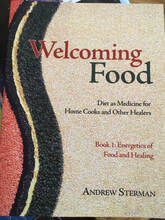
Chinese Medicine
There are 5 pillars of health in Chinese Medicine. One of them is nutrition. Having poor nutrition will often result in poor digestion, absorption of nutrients, and then inflammation. Inflammation makes our tissues less supple and much more sensitive and painful during a massage or Rolf session. As a result the body has a much harder time letting go of unnecessary restrictions.
Seeing as we live in the far North some simple tips that seem to apply to most of us can help:
Don't use a microwave oven, eat no frozen foods, little to no dairy, cooked warm foods and drink warm liquids, and avoid processed sugar.
Here is a book on this topic
There are 5 pillars of health in Chinese Medicine. One of them is nutrition. Having poor nutrition will often result in poor digestion, absorption of nutrients, and then inflammation. Inflammation makes our tissues less supple and much more sensitive and painful during a massage or Rolf session. As a result the body has a much harder time letting go of unnecessary restrictions.
Seeing as we live in the far North some simple tips that seem to apply to most of us can help:
Don't use a microwave oven, eat no frozen foods, little to no dairy, cooked warm foods and drink warm liquids, and avoid processed sugar.
Here is a book on this topic
